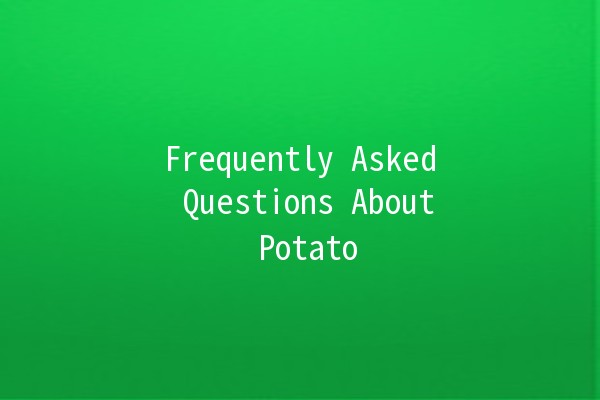Understanding the nuances of potato consumption, cultivation, and history can lead to a more fulfilling experience. Potatoes are versatile and packed with nutrients. Below is a comprehensive exploration of the commonly asked questions surrounding potatoes. The article is structured in a way to provide practical insights as well as productivityboosting tips for potato enthusiasts or those looking to incorporate this healthy vegetable into their dietary routines.
Potatoes are a staple food around the world due to their rich nutritional profile:
High in Vitamins: Potatoes are particularly rich in Vitamin C, which is essential for immune function and skin health. They also contain Vitamin B6, which is important for brain health.
Rich in Minerals: Potatoes provide potassium, which is crucial for heart health and helps to regulate blood pressure.
Low in Calories and Fat: A mediumsized potato has about 130 calories and virtually no fat, making it a healthy choice for those looking to maintain or lose weight.

Source of Fiber: Eating potatoes with the skin can increase fiber intake, which aids in digestion and helps to maintain a healthy gut.
Application Example: For a healthy snack, consider preparing baked potato wedges. Slice potatoes into wedges, sprinkle with olive oil, seasoning, and bake until crispy. This preserves the vitamins while providing a delicious lowcalorie option.
Proper storage of potatoes can significantly extend their freshness and quality.
Cool and Dark Place: Potatoes should be stored in a cool, dark place with good ventilation to prevent them from sprouting. Ideal temperatures are between 45°F to 50°F (7°C to 10°C).
Avoid Refrigeration: Refrigerating potatoes can lead to conversion of starch into sugar, which alters their taste and texture.
Check for Spoilage: Regularly check stored potatoes for soft spots or sprouting, and remove any affected tubers to prevent them from spoiling others.
Application Example: Utilize a breathable bag or basket, ensuring airflow, and keep the bag closed to block out light. Store potatoes away from onions to prevent spoilage.
Understanding the different types of potatoes can enhance your culinary skills.
Russet Potatoes: Known for their high starch content, russets are ideal for baking and frying.
Red Potatoes: These have a waxy texture and are great for boiling and salads due to their ability to hold shape.
Yukon Gold: These versatile potatoes are perfect for mashing, roasting, and baking, thanks to their creamy flesh.
gerling Potatoes: Small and colorful, these potatoes are great for roasting and add visual interest to dishes.
Application Example: When planning a family dinner, organize a potato tasting by preparing a dish using each type. For instance, make a classic mashed potato using Yukon Gold, and a roasted medley featuring red and fingerling potatoes.
The method of cooking can greatly affect the flavor and texture of potatoes.
Boiling: Boil with the skin on to retain nutrients. Add salt for extra flavor, and choose to mash or serve whole as a side.
Baking: Baking potatoes at high heat (450°F or 232°C) creates a fluffy interior. Top with butter, sour cream, or chives for a classic presentation.
Frying: For a crispy outer layer, consider frying thin slices for homemade potato chips. Alternatively, sauté cubed potatoes with spices for added flavor.
Application Example: For a simple but delicious baked potato, try just oiling the skin, sprinkling with salt, and baking. Top with Greek yogurt and herbs to add a gourmet touch.
Understanding common pitfalls can ensure a successful potato dish every time.
Not Washing Potatoes: Always wash potatoes thoroughly to remove dirt and bacteria, especially if you're leaving the skin on.
Cutting Too Small: Small pieces cook too quickly and can become mushy. Aim for uniform sizes for even cooking.
Overcooking: Monitor cooking time carefully to avoid mashed or steamed potatoes turning mushy. Test for doneness with a fork.
Application Example: When making mashed potatoes, boil them just until a fork easily slides into the chunk. Drain and mash immediately for perfect consistency.
Additional Commonly Asked Questions
How Can Potatoes Affect Blood Sugar Levels?
Potatoes have a high glycemic index, which means they can rapidly raise blood sugar levels. However, consuming them with a healthy fat or fiber can help stabilize these effects.
Example: Pair potatoes with a lean protein source like grilled chicken to mitigate blood sugar spikes while enjoying the delicious flavor and texture of potatoes.
Can Potatoes Be a Part of a Weight Loss Diet?
Yes! Because they are low in calories and high in fiber, potatoes can be included in weight loss diets when prepared healthily.
Example: Consider using baked or boiled potatoes in salads or as a base for highprotein meals rather than frying them.
Are Potato Peels Nutritious?
Absolutely! The skin of potatoes is rich in fiber, vitamins, and antioxidants. Eating skins can contribute to better digestion and overall health.
Example: When preparing baked potatoes, keep the skins intact, and serve them topped with herbs or yogurt for a nutritious boost.
What are Some Unique Ways to Use Potatoes in Cooking?
Potatoes can be used in unexpected ways!
Potato Pancakes: Grate potatoes and mix with eggs, onions, and spices to create delicious crispy pancakes.
Potato Soup: Blend boiled potatoes, broth, and cream for a hearty soup that's comforting and filling.
Example: Try creating loaded potato skins as an appetizer, topping them with cheese, bacon, and herbs for a delightful twist.
How Can I Incorporate More Potatoes in My Meals?
Incorporating potatoes in your meals can be simple and delicious. Use them as a base for dishes, mix them into salads, or create a hearty stew.
Example: Create a potato salad with baked potatoes, herbs, and a light vinaigrette. This adds great flavor while being a refreshing dish.
The versatility of potatoes makes them a fantastic addition to any diet. By understanding their nutritional benefits, various cooking techniques, and common pitfalls, you can enjoy using potatoes in countless delicious ways. Feel free to explore the creative recipes and methods that highlight the flexibility of this amazing vegetable.